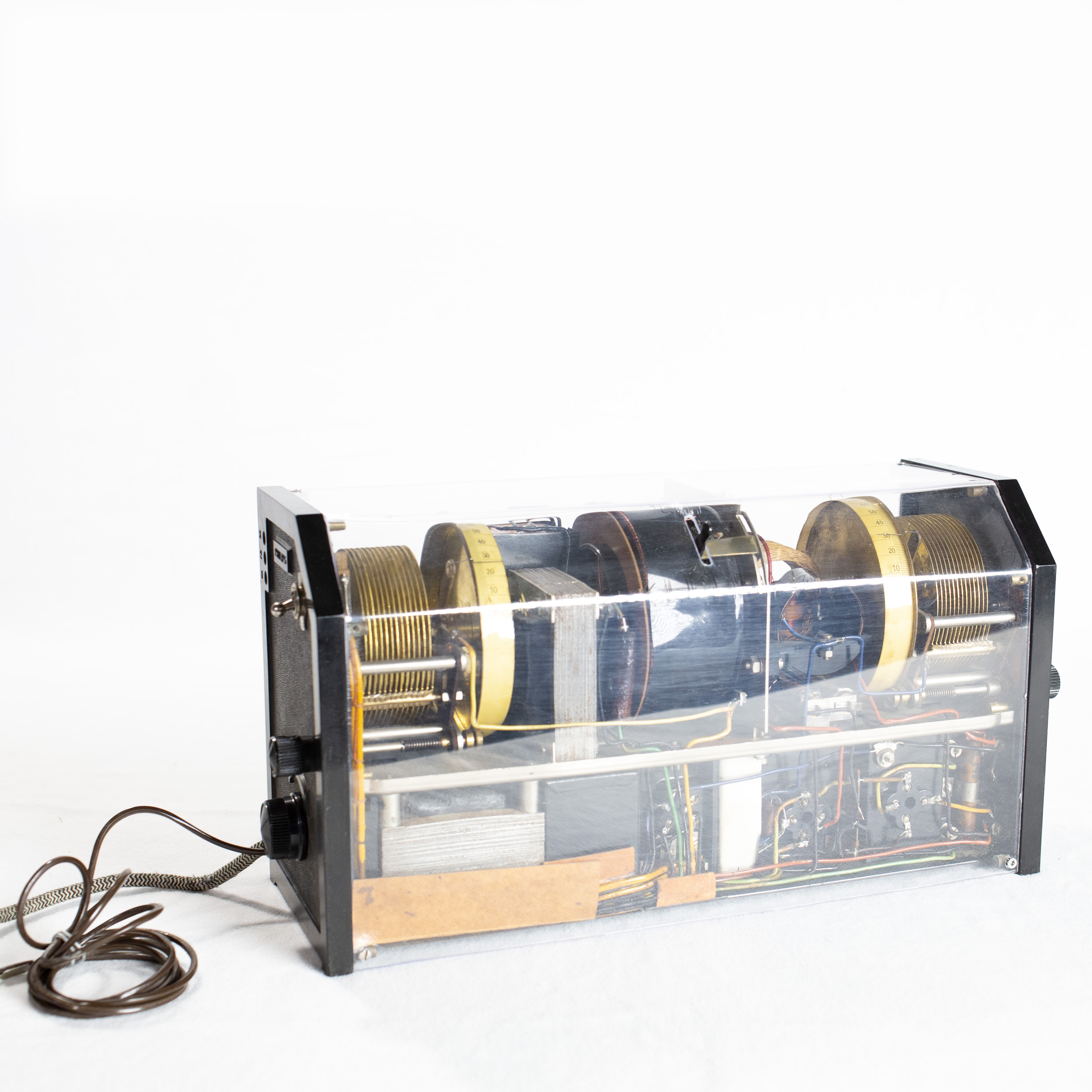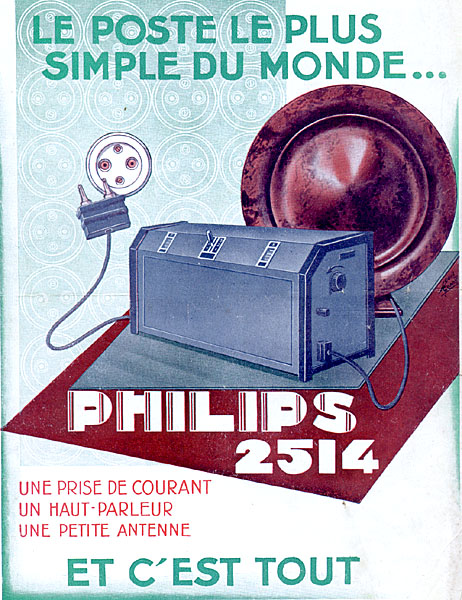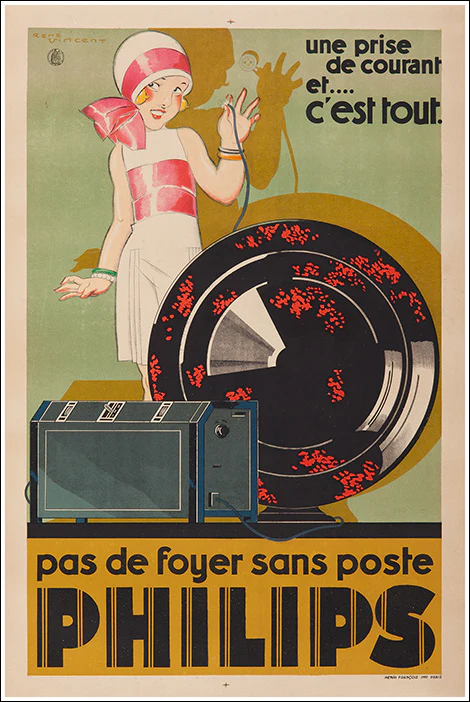
PHILIPS 2514 RADIO
Radio - Music
- Manufacturer: Philips
- Date : c. 1928
- Place of Manufacture: The Netherlands
- Materials: Sheet metal covered in pegamoid or ebonite; vacuum tubes; electronic components
THE PHILIPS 2514 RADIO
The Philips 2514 radio from the Chauvin collection was purchased by Matthieu a few years ago and meticulously restored by Daniel Saint Semmera. It retains its original electronics; only the valves have been replaced with more modern equivalents. The casing, originally made of sheet metal covered in dark pegamoid (a type of black oilcloth), was carefully dismantled and preserved. For exhibition purposes, it has been replaced with a Plexiglas cover, allowing the inner workings and components of the device to be observed.
Launched in 1928, the Philips 2514 was the brand’s first radio fully powered by a 220-volt mains connection. This represented a significant advancement for users, who were no longer burdened with the tedious and often messy task of recharging or replacing batteries – a chore more suited to a chemist than a music enthusiast at the time.
Philips capitalised on this innovation in its marketing, even branding the model as “the simplest radio in the world”. This slogan became a widely used selling point – not only by Philips but also by its competitors.

The Philips 2514 cannot operate without an external loudspeaker, which is why it is often displayed together with the so-called “shaving-dish” speaker (see note). The two devices were commonly purchased as a pair. The ensemble currently on display at Villa Bagatelle remains fully functional to this day.

HOW THE RADIO WORKS
A sound wave causes the diaphragm of a microphone to vibrate, converting the sound into an electrical signal. This current is then amplified using vacuum tubes and transmitted via cable to a broadcasting station. There, it is "imprinted" onto another electrical current known as a carrier wave.
The sound wave and the carrier wave, now tightly bound through modulation, are broadcast into the air as electromagnetic waves — a form of invisible light capable of passing through certain materials. These waves are picked up by a receiving aerial and directed towards the receiver according to their frequency (that is, the number of vibrations per second).
On a radio set, it is precisely this process that is controlled by the variable capacitor dial — in the case of the Philips radio, the two knobs positioned on either side of the device — which allows the user to select the desired frequency - also known as tuning. (See "NOT ON THE SAME WAVELENGTH")
Once the signal has been received, the carrier wave is stripped away by a special valve, freeing the original sound wave. This wave is sent to the loudspeaker, where it causes a second diaphragm — larger, but similar to the one in the microphone — to vibrate, and the voice re-emerges as sound.
At the time, this entire system functioned in real time, as recording technology had yet to be developed.
For further details, the user manual for the Philips 2514 is available next to the radio.
THE HISTORY OF RADIO
Like many other inventions, radio was not the creation of a single individual, but rather the result of a series of technological breakthroughs.
The history of wireless transmission by radio begins in 1886, when German engineer Heinrich Rudolf Hertz demonstrated the existence of electromagnetic waves, capable of travelling at the speed of light. This groundbreaking discovery marked the starting point for research that would ultimately lead to the invention of radio broadcasting and modern telecommunications.
Numerous inventors played a role in this evolution, among them Nikola Tesla and the French physicist Édouard Branly. Tesla succeeded in creating a high-frequency generator operating at 15 kHz, which could serve as a transmitter, while Branly, in 1890, invented the first receiver for Hertzian waves: the coherer (or radio-conductor).
It was a young Italian inventor, Guglielmo Marconi, who brought together the necessary innovations to create a functioning radio system. Towards the end of the 19th century (between 1895 and 1899, depending on the source), he achieved the first long-distance radio transmission by establishing a link between England and France across the English Channel.
At that time, however, radio was still “silent” — only telegraphic messages could be transmitted. It was the Canadian engineer Reginald Fessenden who developed amplitude modulation (AM) of sound and voice, enabling the first wireless broadcast of the human voice on Christmas Day, 1906. Though the sound quality was rather poor, this event is now widely regarded as the birth of modern radio.
The first radio stations began to appear in France as early as 1920. In 1921, Radio Tour Eiffel started broadcasting the country’s first regular radio programmes, heralding the dawn of the public radio era.
NOT ON THE SAME WAVELENGTH
Radio wave bands have evolved considerably since the 1920s. Modern radios no longer necessarily operate on the same frequencies used in the early days of broadcasting.
The Philips 2514 radio primarily received low frequencies, known as long waves (30 to 300 kHz), as well as medium waves, or medium frequencies (530 to 1700 kHz). These bands were the most commonly used for public broadcasts during the 1920s and 1930s.
Over time, these ranges were gradually abandoned in favour of shortwave, and later very high frequency (VHF/FM) bands, which offer significantly better sound quality and more stable transmission — particularly suitable for music.
There are no longer any broadcasts on the waveband used by the Philips 2514 radio. However, a small transmitter connected via a mini-jack to the headphone socket of an audio device converts the sound into radio waves, which can then be received by the radio’s antenna and played through its original 1920s electronics and loudspeaker.
Sources & Further Reading
- 1jour1actu. “Qui a inventé la Radio ?.” Norédine Benazdia, Culture. 18 février 2022.
- Agence Nationale des Fréquences. “C’est quoi le spectre des fréquences ?.” À propos de l’ANFR.
- Centre Pompidou. “Radio Modèle 1927 Avec Haut-parleur “Plat À Barbe”.” Centre Pompidou.
- CFP Radio. “Récepteur PHILIPS type 2514.” Restauration.
- CNRTL. “Ébonite : définition.” CNRTL.
- Cobra. “L’histoire de la radio : des origines à aujourd’hui.“ Guillaume Cobra. 30 janvier 2025.
- DOCTSF. “Philips - 2514 Radio.” DOCTSF : Le Grand Livre de la TSF.
- GAUTIER-LANGUEREAU (éditeur). Grandes Inventions : le XXe siècle. Gautier-Languereau, l’Univers en couleurs, 1966. (Collection Chauvin)
- L’Encyclopédie Canadienne. “Reginald Fessenden.” Article.
- Olga Novel & Michel Terrier. “Philips 2514 (1928).” Michel Terrier.
- RFI. “La Radio, une longue histoire qui continue.” Nenad Tomic et Anoushka Notaras, RFI, Connaissances. 31 mai 2021.
Notice written by:
Louise Sartoretti
Translated with DeepL and Chat GPT
Last updated: 30 May 2025